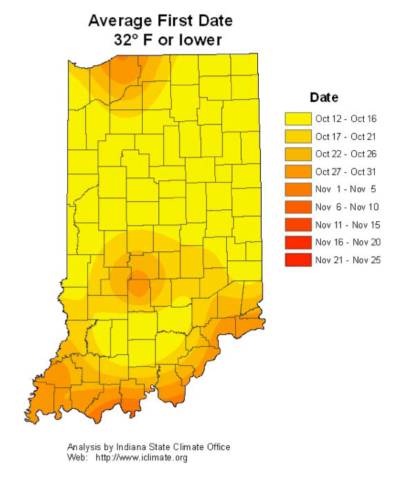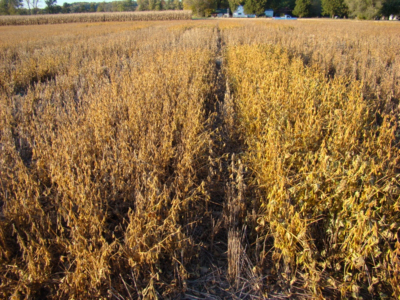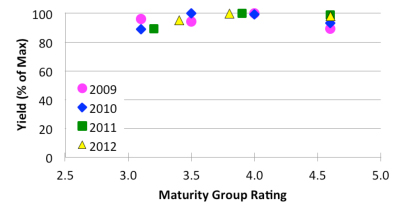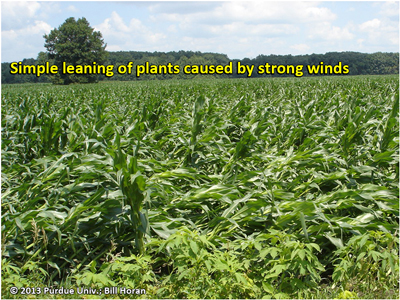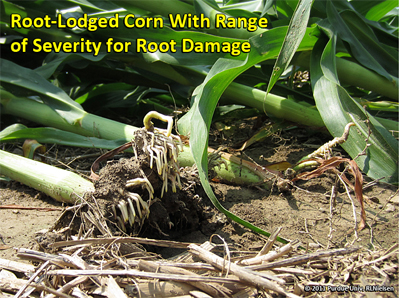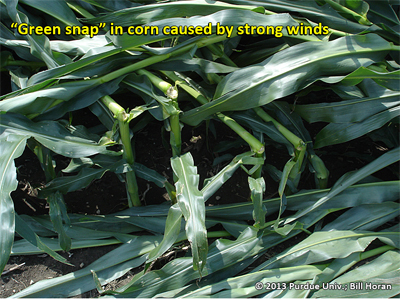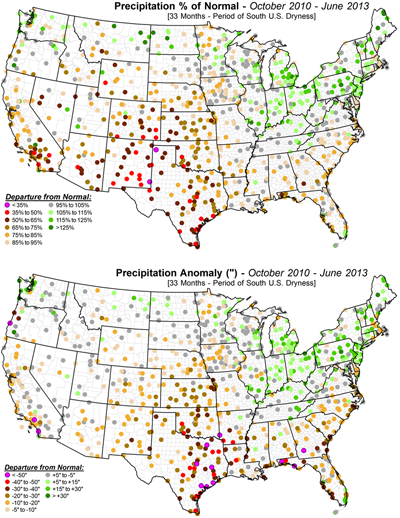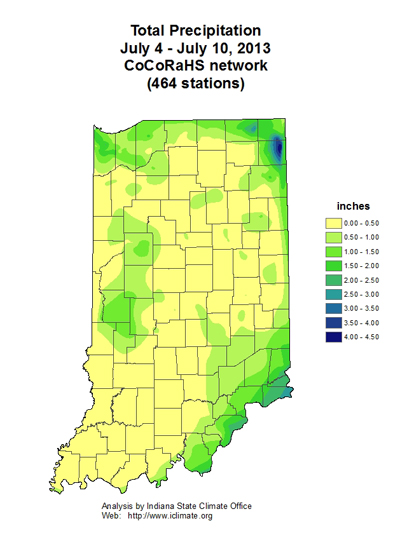USDA-NIFA Extension IPM Grant
Pest & Crop Newsletter, Entomology Extension, Purdue University
Corn Rootworm Resistance: Latest News and What it Means for Indiana Producers- (Christian Krupke) -
• No Indiana reports of “problem fields” of Bt corn.
• Rootworm pressure expected to continue to be low
statewide.
• Indiana producers ideally positioned to avoid problems
seen to the west.
Corn rootworms continue to make news. Most readers are familiar with the reports of resistance from the western part of the Corn Belt. These originated in Iowa and were summarized first in a publication by Dr. Aaron Gassmann’s lab at Iowa State and can be accessed at this link (click here).
Briefly stated, field resistance has been confirmed in Iowa and other states west of us, including parts of Illinois. There has been some confusion and parsing of words in media and industry reports about whether this is truly resistance, or just due to high pressure in fields. However, among corn rootworm scientists at the USDA and public universities there is consensus that rootworms in these fields are indeed resistant to the Cry3Bb1 toxin, found in many commercial corn hybrids – including the popular multi-trait stacks (e.g., SmartStax). This was the first toxin marketed for rootworm control, back in 2003, when it was sold under the YieldGard brand name.
This week a report on NPR highlighted current performance issues in Nebraska, that report (including audio) can be accessed here (click here).
Rootworm damaged roots, a rare find of recent in Indiana
This may cause some consternation and worry among Indiana producers, but it really shouldn’t. Most producers should keep doing what they have been doing (including planting a refuge), and be vigilant as we are now passing through the peak feeding period of rootworm larvae. Indiana is in a good spot to weather this storm, at least for a while, for several reasons.
First off, the reports indicate that resistance has arisen independently in these different areas – as opposed to spreading out from a focal point. In problem fields, there has been a history of several years of continuous corn expressing the Cry3Bb1 rootworm trait. Few Indiana fields meet that description, largely because the vast majority of producers here rotate with soybeans. Rotation to a non-host crop like soybeans remains the single most powerful and effective method of delaying rootworm resistance to Bt. Zero rootworm larvae will survive in a “clean” soybean field. This underscores the importance of removing glyphosate-tolerant volunteer corn, easily done with a grass herbicide. Don’t be confused by the term “soybean variant” – this just means females will lay eggs in soybeans (and other non-corn) this fall. The larvae still need the same food source – corn – when they hatch the following spring. If they don’t find that corn within about 24 hours, they die.
In addition, corn growers will want to consider rotating technologies for rootworm control if at all possible. This includes switching Bt toxins. An even better option is occasionally switching to granular and/or liquid insecticides, especially when rootworm populations are a low-risk. Layering the granular products “on top” of Bt traits is not recommended – this will provide control, but will also keep the pressure on insects to evolve resistance to the Bt toxins, which is exactly what we need to avoid. A final point in our favor is that our rootworm populations have been very low for several years running. That means the chances of resistance development are lower here than in states with very high pressure. That could change in the future, but for now we are in a good spot and need to make sure things stay that way.
For a full summary of corn entomologists’ recommendations to keep Bt in the pest management arsenal, please see this link (click here).
![]()
Corn Earworm Pheromone Table Link - (John Obermeyer) –
Capturing corn earworm moths with black light traps has not been a reliable method of determining population swings throughout the season, whereas pheromone trapping is. We are removing corn earworm from the black light table so as not to confuse those relying on the data. We now provide a link to a new corn earworm pheromone trapping table covering many locations in the state. Those with earworm sensitive crops (sweet, seed, popcorn, etc.) should find this daily updated data quite valuable. Thanks to Rick Foster, Purdue Vegetable/Fruit Entomologist, and the Purdue Agriculture Centers that have made this trapping information available.
Check out the Corn Earworm Pheromone Trap Data “HERE”.
![]()
Click here to see the Black Light Trap Catch Report
Western Bean Cutworm Adult Pheromone Trap Report
![]()
Conditions Favorable for Foliar Diseases of Corn – (Kiersten Wise)
Rainy, humid weather has increased the likelihood of foliar diseases developing in corn in 2013. Gray leaf spot (Figure 1) is appearing in the lower canopy of susceptible hybrids across Indiana, and northern corn leaf blight (Figure 2) has also been observed in the lower canopy of fields in northern Indiana. The bacterial disease Goss’s wilt (Figure 3) has been confirmed in popcorn and hybrid corn in northeast Indiana. Many fields across Indiana are currently at a younger growth stage than normal due to delayed planting, and therefore may be at greater risk for yield loss due to disease development.
Fungicides are available to manage foliar diseases such as gray leaf spot and northern corn leaf blight. Research in Indiana indicates that fungicides are most effective at preventing yield loss due to disease when applied at the tasseling to early silking (VT-R1) growth stage. Scouting fields around V14, or just prior to tassel emergence, can help determine the level of disease pressure in a field.
Recommendations for In-season Management of Gray Leaf Spot:
Iowa State University developed guidelines to determine when a fungicide may be necessary to prevent yield loss from gray leaf spot. These thresholds incorporate hybrid susceptibility ratings to gray leaf spot and disease levels prior to tasseling:
1. Consider a fungicide application if:
The hybrid is rated as susceptible or moderately susceptible AND 50 percent of the plants in a field have disease lesions present on the third leaf below the ear leaf or higher prior to tasseling. Please see the following video for identifying the area on the plant to scout for disease threshold decision-making: <http://www.youtube.com/watch?v=OCpwhvw9W_Y&feature=c4-overview-vl&list=PL1DCC2F39021955FF>.
2. Consider a fungicide application if:
The hybrid is rated as moderately resistant AND 50 percent of the plants in a field have disease lesions present on the third leaf below the ear leaf or higher prior to tasseling AND additional factors or conditions that favor disease development are present (residue present, favorable weather conditions)
Scout resistant hybrids for disease problems, but in general, fungicide applications to resistant hybrids are not recommended and will not consistently result in increased yield. For more information on gray leaf spot, please read Purdue Extension bulletin BP-056-W: <http://www.extension.purdue.edu/extmedia/bp/BP-56-W.pdf>.
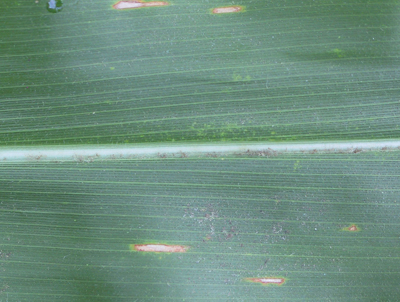
Figure 1. Early symptoms of gray leaf spot on corn.
Recommendations for In-season Management of Northern Corn Leaf Blight:
Currently we do not have thresholds available for determining when fungicide applications are needed for northern corn leaf blight, but we follow similar guidelines as gray leaf spot, in that fungicides will typically be more beneficial when applied to susceptible hybrids in high-risk fields for disease development, such as those that are in minimum or no-till. For fungicide recommendations, please see the updated fungicide efficacy table for management of corn diseases, which is developed by the national Corn Disease Working Group: <http://www.extension.purdue.edu/extmedia/BP/BP-160-W.pdf>. For more information on northern corn leaf blight, plese read Purdue Extension bulletin BP-084-W: <https://ag.purdue.edu/btny/Extension/Pages/ExtPubs.aspx>.
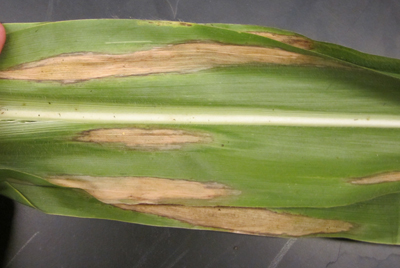
Figure 2. Elliptical lesions characteristic of Northern corn leaf blight.
Recommendations for In-season Management of Goss’s Wilt:
Goss’s wilt is a bacterial disease, and therefore fungicide applications will not be effective at reducing disease development. There are several products promoted for in-season management of Goss’s wilt, however, Indiana research indicates that these products do not consistently reduce disease once symptoms are present on the plant. If symptoms of Goss’s wilt are suspected in a field, please remember to have the sample confirmed by a diagnostic lab. Fields with confirmed Goss’s wilt should be planted to a hybrid that is more resistant to Goss’s wilt in subsequent years. Tillage and crop rotation will also help reduce the amount of residue that can harbor bacteria for the next corn crop. For more information on Goss’s wilt, please read Purdue Extension Bulletin BP-081-W: <https://ag.purdue.edu/btny/Extension/Pages/ExtPubs.aspx>.
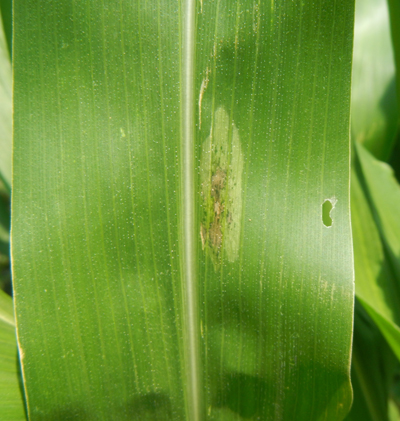
Figure 3. Early symptoms of Goss's wilt on corn include characteristic black "freckles" and water soaking symptoms on leaves.
Before Deciding on a Management Strategy, Keep This in Mind:
The thresholds and recommendations available for in-season management decisions for any disease are not hard and fast rules. It is important to remember that disease severity can be unpredictable in Indiana, even when factors favoring disease are present. Before deciding on in-season management of any foliar disease, consider threshold guidelines, cropping practices, planting date, predicted weather conditions and economic factors, and manage expectations for what type of yield response a in-season fungicide/bactericide application will provide.
![]()
Double Crop Soybean Planting Decisions - (Shaun N. Casteel) -
Wheat development was delayed this season with the extension of the cooler temperatures into the spring. The cool and wet spring benefited many fields of wheat with extended period of grain fill. Unfortunately, the rain cycle continued for many of our areas as the wheat matured in June and now, into July. As of Monday, July 8, Indiana has only harvested 32% of the wheat crop compared to the five year average of 69% (USDA-NASS, 2013). Needless to say, this year’s wheat harvest is a polar opposite compared to 2012 when nearly every acre was already harvested. Delayed wheat harvest directly affects our double crop soybeans.
Double crop soybean production is typically successful in the southern half of Indiana with mixed results in the central and northern areas. The primary source of success is the number of days from emergence to maturation before a freeze kills the crop. In general, the southern areas experience the first fall freeze later than the northern areas (Fig. 1). The other major factor in double crop soybean success is soil moisture, especially during establishment. Fortunately, the lack of soil moisture should not be a limitation this year.
Planting Date
The rule of thumb for delayed planting of soybean is 90 days. Soybean needs at least 90 days prior to the fall freeze to mature enough for a harvestable crop. The soybean could mature completely in some years. While in other years, the soybean is nearing the end of seed fill (R6 – full seed) or leaves are dropping and pods are turning yellow-brown (R7 – first signs of physiological maturity). In the latter cases, the freeze could arrest seed fill resulting in small seeds that are sometimes green in color, but are still harvestable.
If the median fall freeze date (i.e., 2 out of 4 times the freeze will occur at this date) is October 15, then the last planting date for your soybean would be near July 15 (~90 days prior to the freeze). Many areas in southern Indiana typically do not experience the first freeze until October 26 (Fig. 1), so the latest planting date would be close the July 26. Please remember that these are estimates based on a 50% probability of the fall freeze, so earlier or later freezes are possible. You can use Fig. 1 or the fall freeze table in the Corn & Soybean Field Guide (ID-179, p. 292-295) as a reference point.
Figure 1. Average first fall freeze 32°F or lower) in Indiana. <www.iclimate.org>.
The timeline of 90 days is more accurately described from soybean emergence rather than planting date. If you have adequate soil moisture, double crop soybeans should emerge within five to seven days. However, soybeans could take several weeks to emerge waiting for a timely rain because the soil is too dry. Some double crop soybeans took nearly six weeks to emerge last year during the drought. You will need to assess your field conditions and adjust accordingly.
Figure 2. Double crop soybean maturation in 2009 at Vincennes. Picture taken Oct. 19, 2009. Maturity group 4.0 is the plot on the left and maturity group 4.6 is on the right.Maturity Group
Planting dates and maturity groups is a fairly regular topic of discussion for first crop soybeans across Indiana, but not as common in double crop soybean. We have been conducting maturity group studies of double crop soybean at our Southwest Purdue Ag Center near Vincennes for the past four years (Fig. 2). Fortunately, we have also determined reproductive growth stages that support the 90-day rule of thumb.
The maturity groups ranged from 3.1 to 4.6 (Figs. 2 and 3) with 4.0 to 4.5 as the typical choice for double crop soybean in that region. We did not take note of the emergence date, but it was probably within 5 to 7 days due to adequate soil moisture. You will notice the time to full seed (R6) was ~80 days for early 3 maturity group to 85 days for the mid 4 maturity group. The time to full maturity (95% harvest colored pods, R8) ranged from ~100 to 110 days in 2010 and ~110 to 120 days in 2011. Our rule of thumb of 90 days placed the full season cultivars halfway between R6 and R8; whereas, the shorter season cultivars were much closer to R8 (Fig. 3).
The yield potential is typically higher with full season cultivars provided there is enough time to mature the crop. Over the past four years at Vincennes, the late 3 to 4.0 maturity group yielded the best as double crop (Fig. 4). In light of this summer’s rain patterns and the harvest timing of the wheat, the performance of the mid 3s is impressive with yields that are 95 to 100% of the top yielder. If the calendar is approaching our 90-day tipping point, you might consider switching to a shorter season cultivar (0.5 to 1.0 maturity group unit less) in order to mature ~4 to 8 days sooner (Fig. 3) and still yield relative good (Fig. 4). You can plant an even shorter season cultivar, but the yield potential would certainly be less. It all about what you are willing to risk – length of growing season vs. yield potential.
Figure 3. Time to reach R6 (full seed) and R8 (full maturity) based on maturity group when planted as double crop in southwestsern Indiana (Vincennes in 2010 and 2013).
Figure 4. Average first fall freeze 32°F or lower) in Indiana. <www.iclimate.org>.
Seeding Rate
My final bit of advice is to be certain that your seeding rates are high to make up for the limited vegetative growth that will occur with these delayed plantings. The concept is to make up nodal development (and presumably pod development) on individual plants with more plants. Secondly, high plant populations will “push” the height of the first pod higher to aid at harvest. Seeding rates of 180 to 220 thousand seeds per acre will be general targets with the higher rates for later plantings and for shorter season cultivars.
References:
USDA-NASS. 2013. Crop Progress and Condition. USDA, National Agricultural Statistics Service. [On-line]. Available at <http://www.nass.usda.gov/Statistics_by_State/Indiana/Publications/Crop_Progress
_&_Condition/2013/index13.asp>. [URL accessed June 2013
![]()
Damage to Corn Plants by Strong Winds – (Bob Nielsen) -
Storms packing strong winds have rolled through Indiana several time already this growing season. Recent storms, in particular, caused quite a bit of damage to the corn crop in some fields. The damage includes minor leaning or bending of plants, outright uprooting of plants (root lodging), and the so-called “green snap” phenomenon where stalks literally break off or snap above a stalk node (often below the harvestable ear).
The crop is particularly vulnerable to such damage from strong winds when it is in the latter stages of the rapid growth phase prior to pollination, wherein overall plant and root dry matter increases rapidly but more importantly, stalk internode elongation occurs very rapidly. Rapid elongation of the stalk internodes (the tissue between the stalk nodes or “joints”) often outpaces the lignification of the same tissue. The development of lignins provide the structural strength to the stalk.
• Assessing the damage and predicting the eventual effect on grain yield from such damage can be challenging. The one certain advice that can be given is that such assessment should not be done the day after the storm. Rather, you should wait at least 4 to 5 days to allow the damaged plants to demonstrate whether or not they will recover.
• Simple leaning or bending of plants caused by strong winds represents the least of the damage. Such plants should recover most, if not all, of their uprightness AND if this recovery occurs prior to pollination, there should be little effect on the success of pollination. However, if the damage occurred near the onset of pollen shed and silking, then there may be some “shading” of the exposed silks (relative to pollen capture) by the leaves and stalks of neighboring lodged plants and pollination may not occur successfully.
• Plants that are root-lodged often recover by “goose necking” or gradually returning to uprightness, as demonstrated two years when similar strong storms caused wide areas of uprooted plants (Nielsen, 2011a, 2011b). Much like the assessment of plants that are simply leaning from wind, if the “goose necking” of root-lodged plants does not occur before the onset of pollen shed and silking, then there may be some “shading” of the exposed silks by the leaves and stalks of neighboring lodged plants and pollination may not occur successfully.
The likelihood that “green snapped” plants will recover is obviously low. Plants snapped off below the harvestable ear clearly represent direct loss of yield potential, but plants snapped off above the harvestable ear may yet produce grain, albeit less than desired. Because such reduction in harvestable plant population occurs so “late in the game”, there is less opportunity for compensation by neighboring plants and so the estimated yield loss will be approximately equal to the percent of green-snapped plants.
Related Reading
Butzen, Steve. Brittle Snap Injury in Corn. DuPont Pioneer. [online] <https://www.pioneer.com/home/site/us/agronomy/library/brittle-snap/> [URL accessed July 2013].
Nielsen, RL (Bob). 2011a. An Example of “Recovery” From Severe Root-Lodging. Corny News Network, Purdue Extension. [online] <http://www.kingcorn.org/news/articles.11/FlatCorn-0728.html> [URL accessed July 2013].
Nielsen, RL (Bob). 2011b. Prospects of Recovery for Root-Lodged Corn. Corny News Network, Purdue Extension. [online] <http://www.kingcorn.org/news/articles.11/FlatCorn-0726.html> [URL accessed July 2013].
Thomison, Peter. 2011. Green Snap” Damage to Corn. Ohio State Extension C.O.R.N. [online] <http://corn.osu.edu/newsletters/2011/2011-23/201cgreen-snap-damage-to-corn> [URL accessed July 2013].
![]()
Weather Outlook by WS OHRFC - (James Noel, NOAA/NWS/Ohio River Forecast Center) -
The pattern from July 11 to July 25 will be dominated by a typical summer-time high pressure aloft with a quite warm and humid weather pattern and scattered showers and storms from time to time. With abundant moisture in the ground and the corn crop reaching its maximum release of moisture, except a quite humid weather pattern after a few day break that lasts into the start of the weekend of July 12-14. Temperatures will only be a few degrees above normal for maximum temperatures but expect overnight lows to be much more so above normal due to high moisture content overall the next few weeks. Normal highs are in the mid 80s and normal lows are in the mid 60s.
Even though the trend in rainfall is toward a relaxation, do not expect no rain. Rainfall will average normal to slightly below normal the next two weeks in much of Indiana. Normal is 1.5 to 2 inches for that time period.
The latest two week rainfall can be seen here: <http://www.erh.noaa.gov/ohrfc/HAS/images/NAEFS16day.pdf>.
Overall, since 2010, rainfall has been above normal in Indiana. The exception was 2012. See attached graphic for departures from normal since 2010.
![]()


